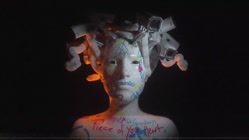The Seljuks - Epic Music
You can buy this track and more of my music here:
https://faryafaraji.bandcamp.com/trac...
Music and vocals by Farya Faraji, part of the lyrics by Omar Khayyam. With this track, I was inspired to make a fusion of Turkish and Iranian musical traditions to represent the Seljuk Empire of the Middle-Ages: a Turko-Persian state founded by Oghuz Turks, which used Persian language and culture as its foundational elements, and ruled over large swaths of the Middle-East, namely over Iran and Anatolia. Please keep in mind that though many aspects of this song are applicable to the era, this is a fusion of modern Turkish and Iranian music and by no means meant to be a historical recreation from the era.
The musical element is centered around the music of Sufi mystics: Muslims who utilise music as a means of expression to be closer to God through the use of Zikr; ritualistic musical ceremonies where they enter a feeling of trance. Drums such as the daf and bendhir, used here, will provide a strong percussion element, often accompanied by rhythmic breaths and phrases of religious nature. This focus on Sufism is due to the strong tendency towards Sufism present within the Seljuk dynasty and Turko-Persian tradition.
The instruments are the Turkish bağlama, an Iranian dotar from the south of Khorasan, and the ney, a flute commonly used by Sufi orders for their rituals, as well as an Iranian santour.
The lyrics are in Early Modern Persian and in Old Anatolian Turkish, the variety of Turkic that was growing out of Common Oghuz Turkic at the time to develop into the Turkish language of today. The Persian lyrics are a quatrain by the revered Persian poet Omar Khayyam, who lived in Iran during the rule of the Seljuk Empire—the lyrics are thus contemporary to the era.
Persian lyrics:
مرغی دیدم نشسته بر باره طوس
در پیش نهاده کله کیکاووس
با کله همی گفت که افسوس افسوس
کو بانگ جرسها و کجا ناله کوس
Morghi didam neshaste bar bāreye Tus,
Dar pish nahāde kalleye Kay Kāvus,
Ba kalle hami goft: avsoos, avsoos!
Koo bānge jarass-hā va kojā nāleye koos?
I saw a bird perched on the walls of Tus,
Before him lay the skull of Kay Kavus,
And thus he spoke: “alas! alas!”
Thy drums are hushed, thy larums have rung truce
The reason I chose this specific quatrain, other than being contemporary to the Seljuk era, is that it speaks of the long gone era of pre-Islamic Iran. Ancient Iran and the mythological days of the Kayanian dynasty are gone, and the land has entered the Middle-Ages, where Islam and Turkic presence will now play a significant role, and in return, contribute to the spread and cultural hegemony of the Persian language and the Persianate states.
Old Anatolian Turkish lyrics:
Ve cāhil gişileri gişi sanma,
Ve hünersüzleri bilür sayma.
And do not consider the ignorant ones as real men, and do not consider the untalented ones knowledgeable ones.
























